
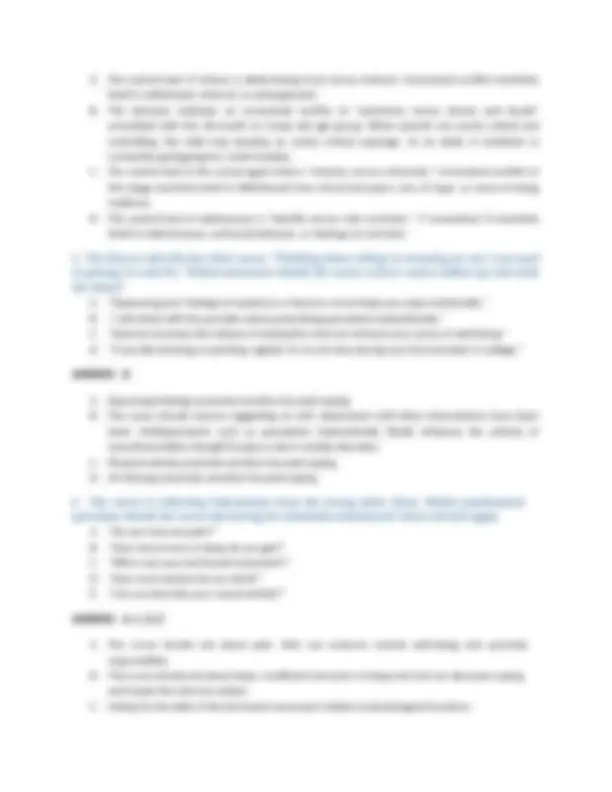
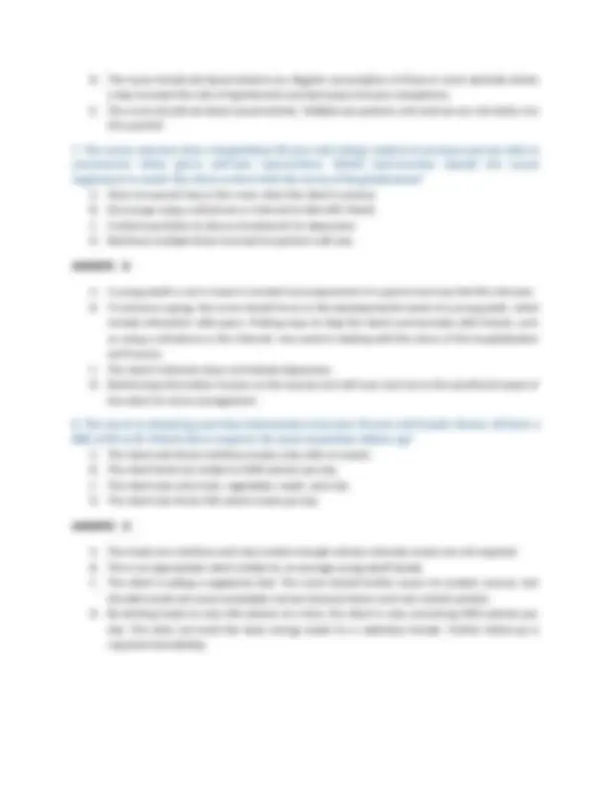
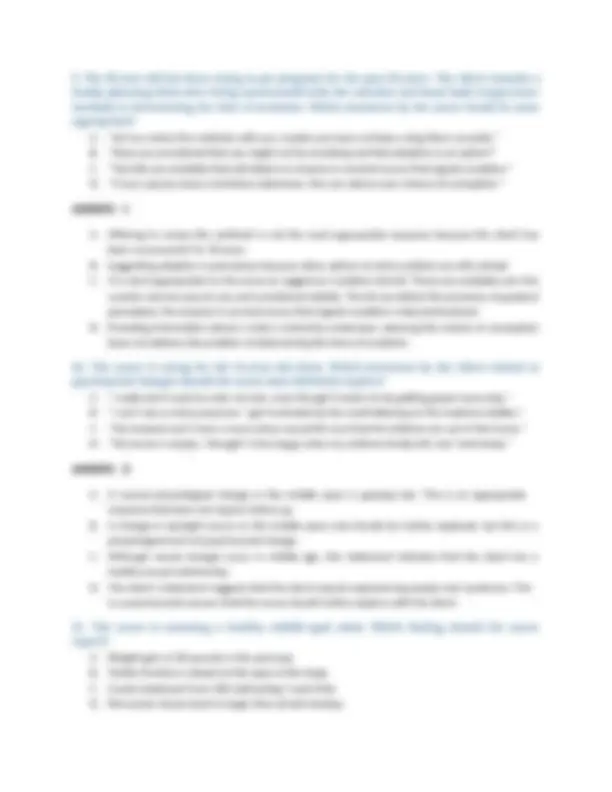
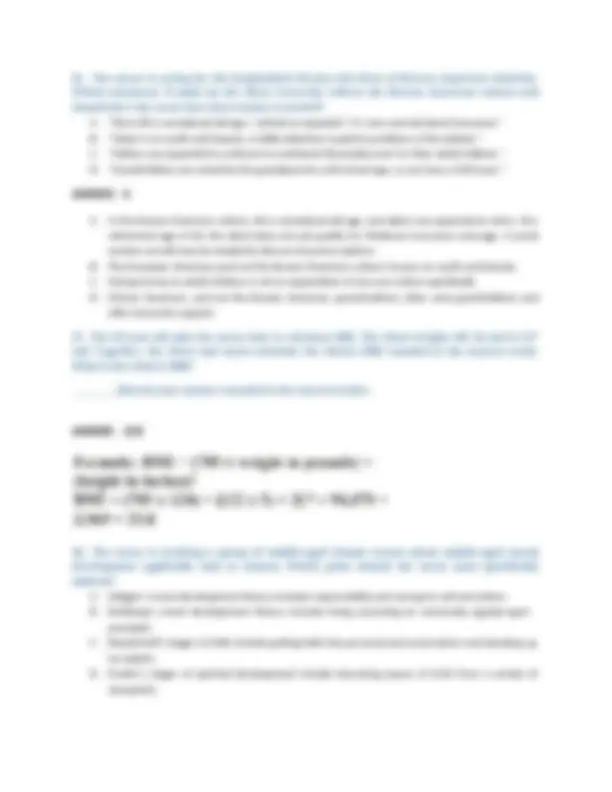
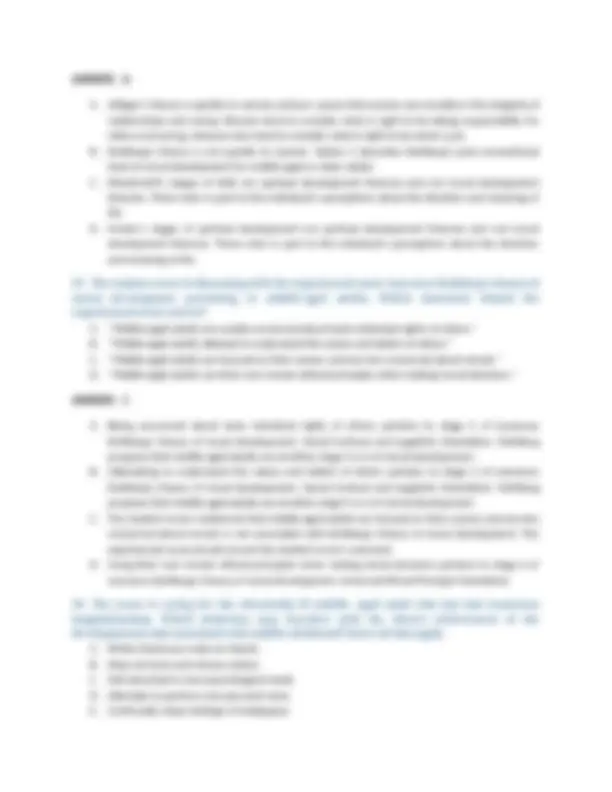
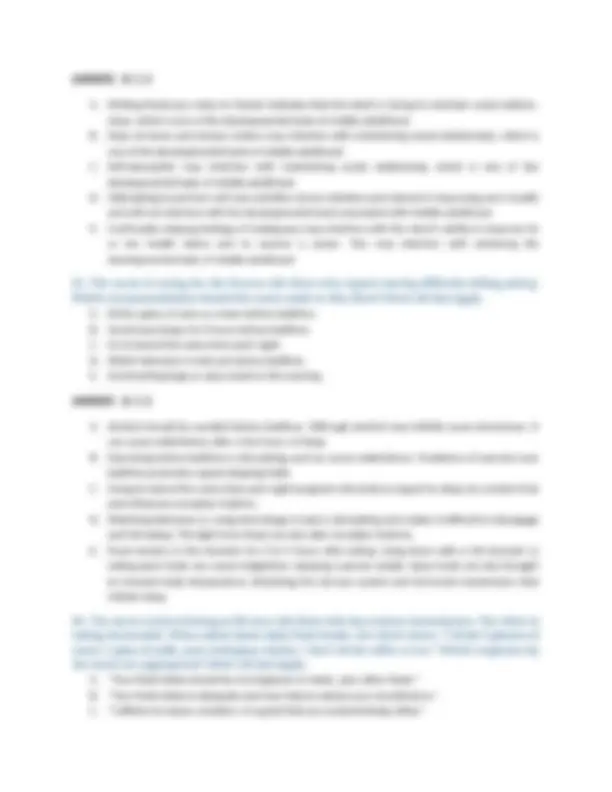
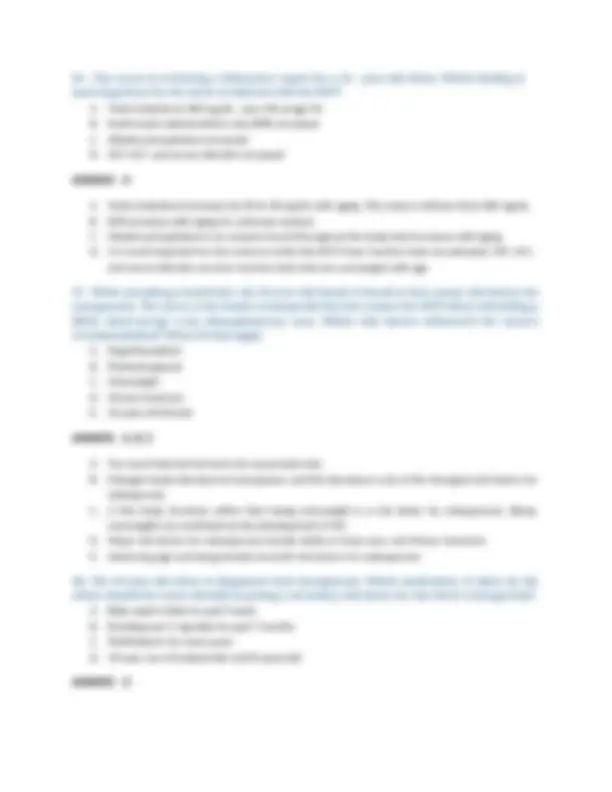
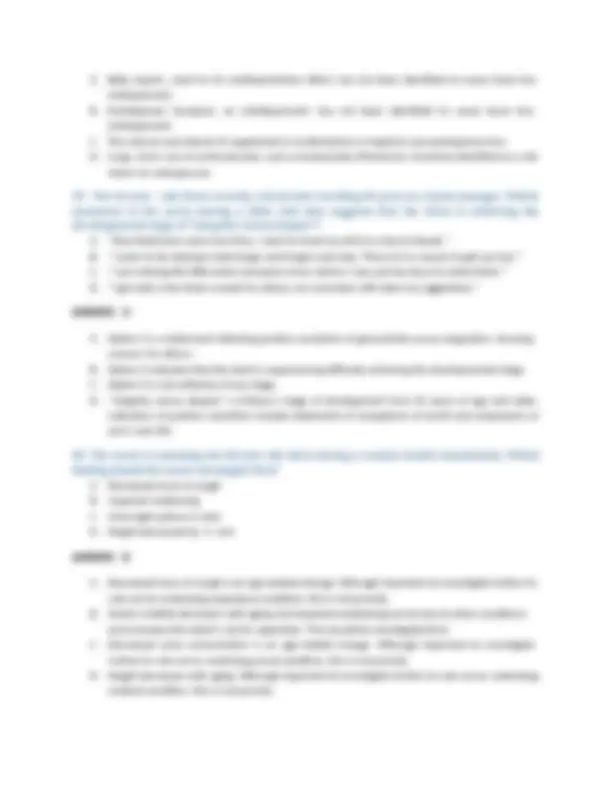
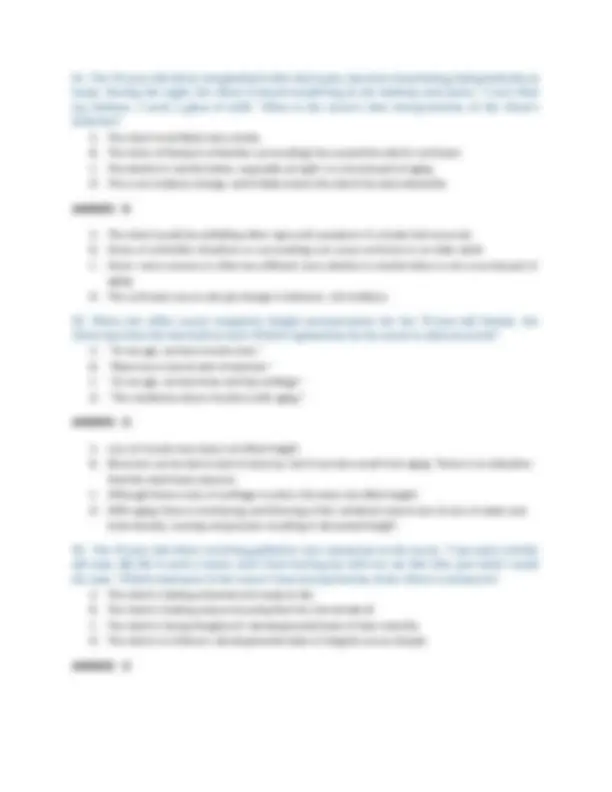
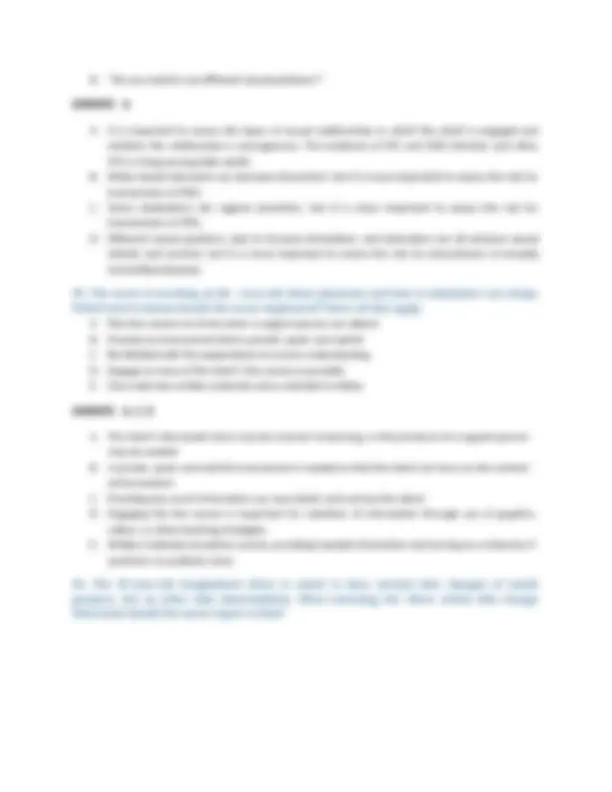
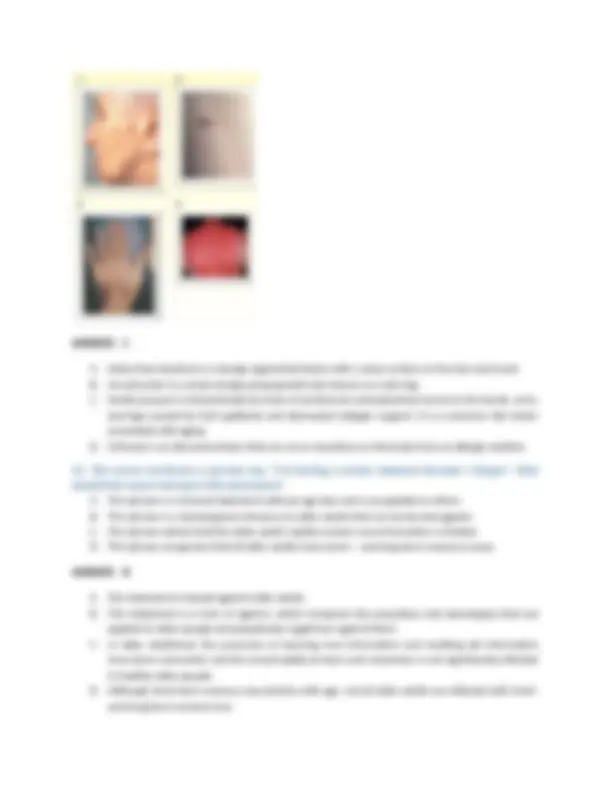
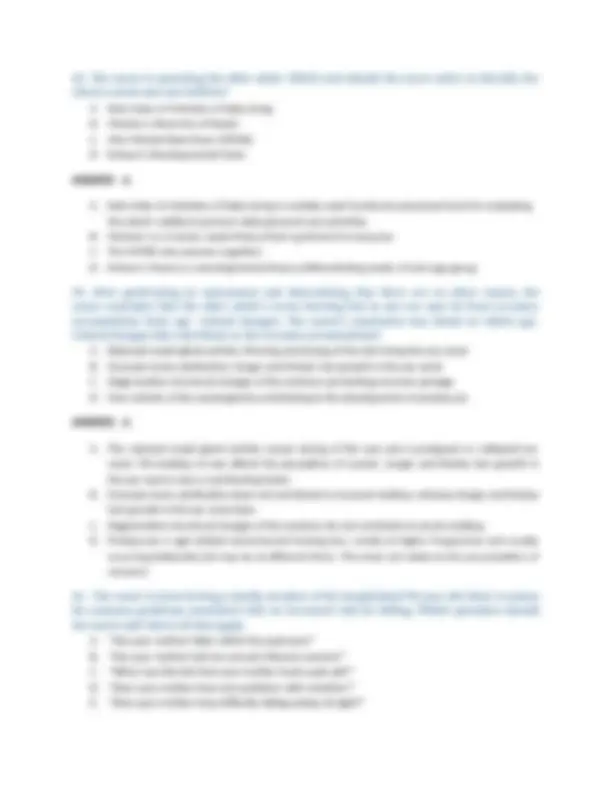
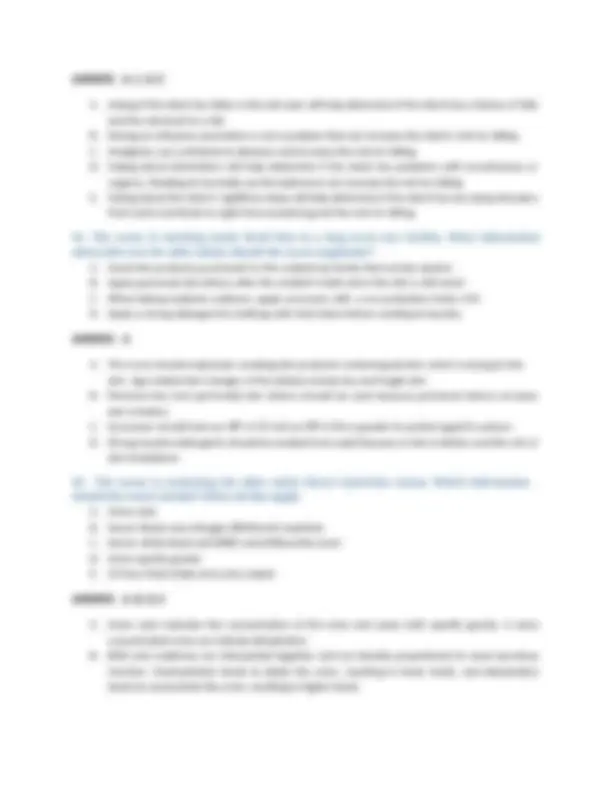
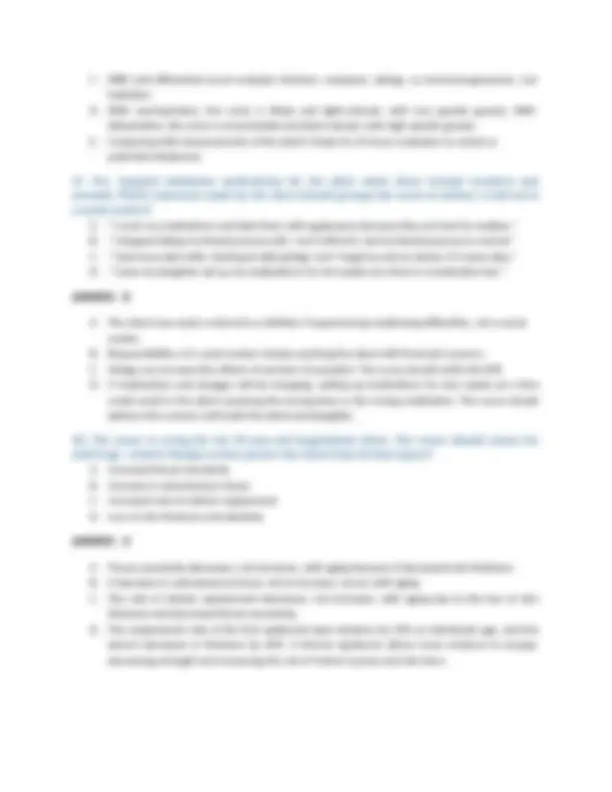
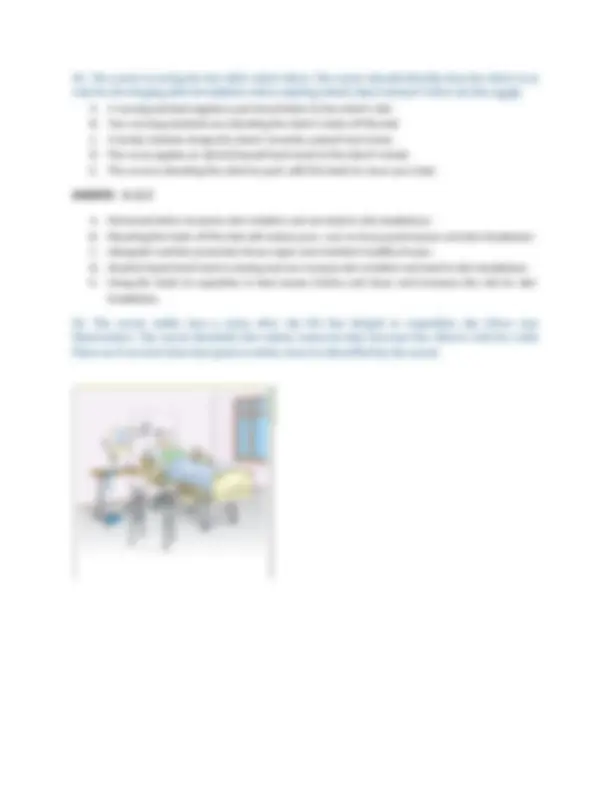
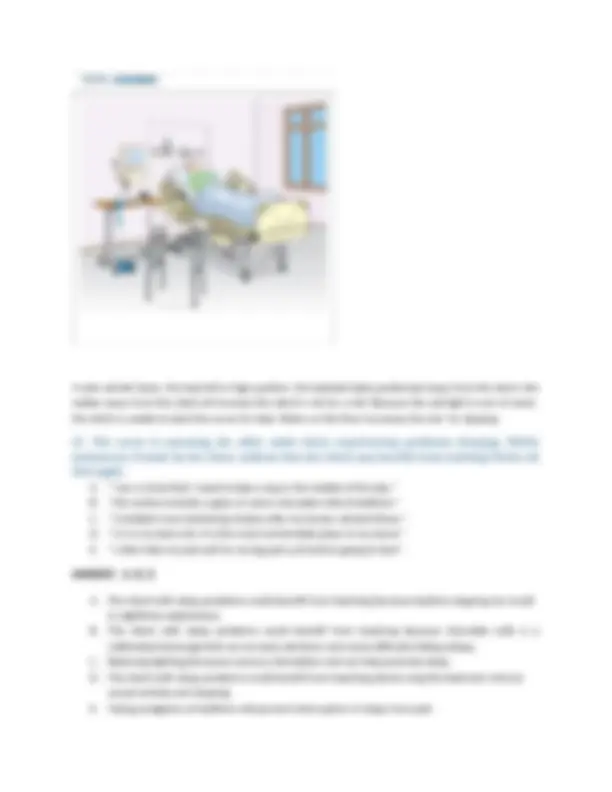
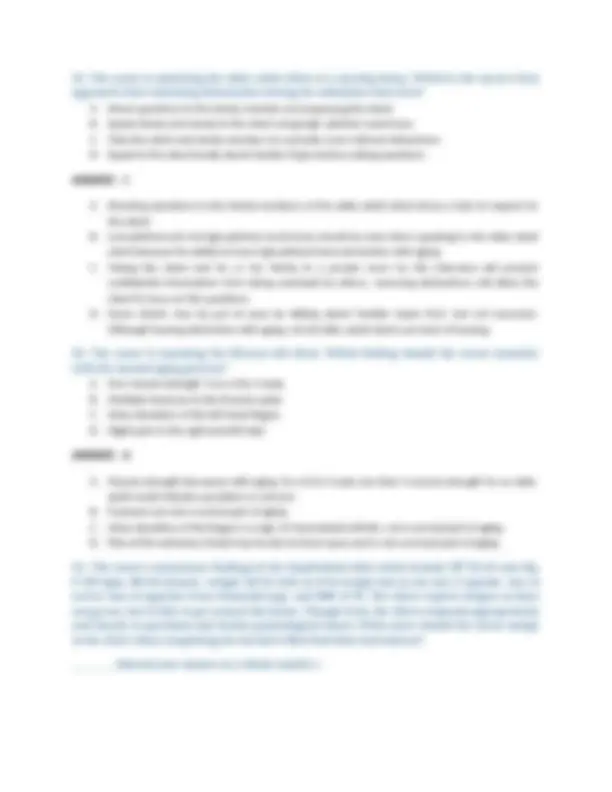
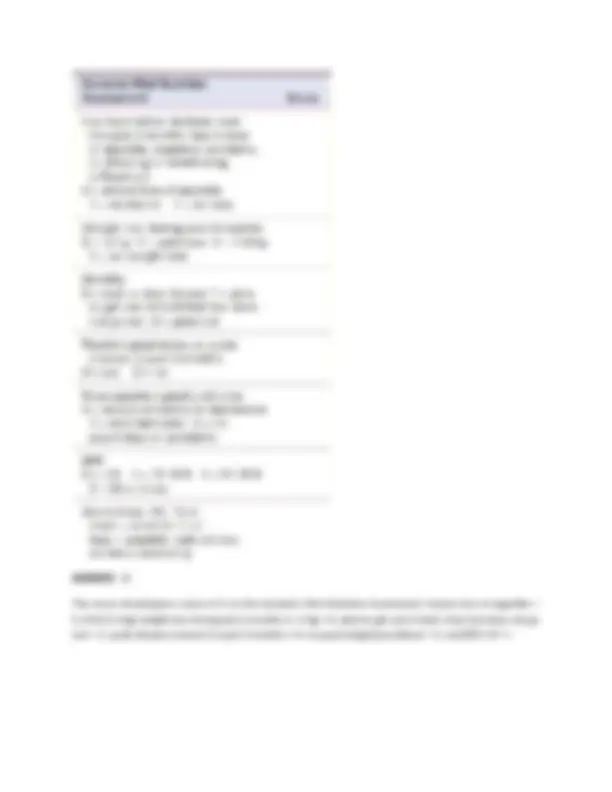
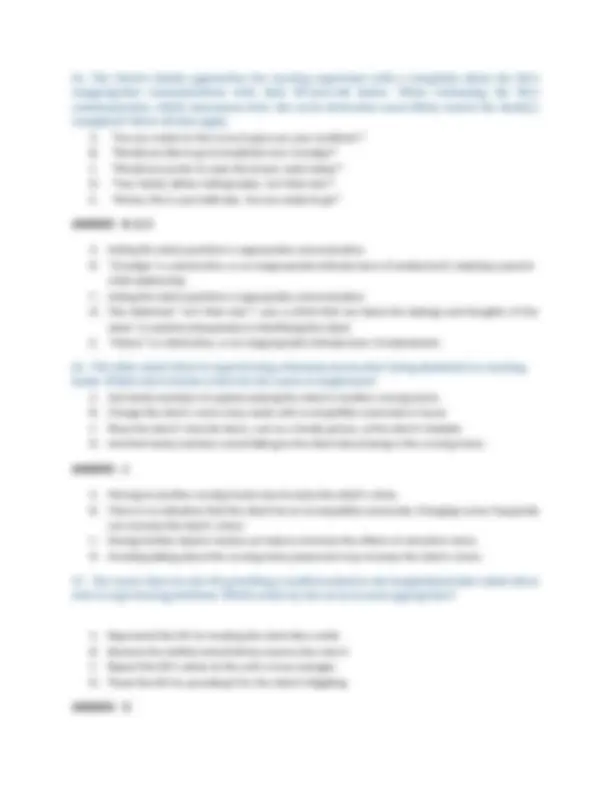

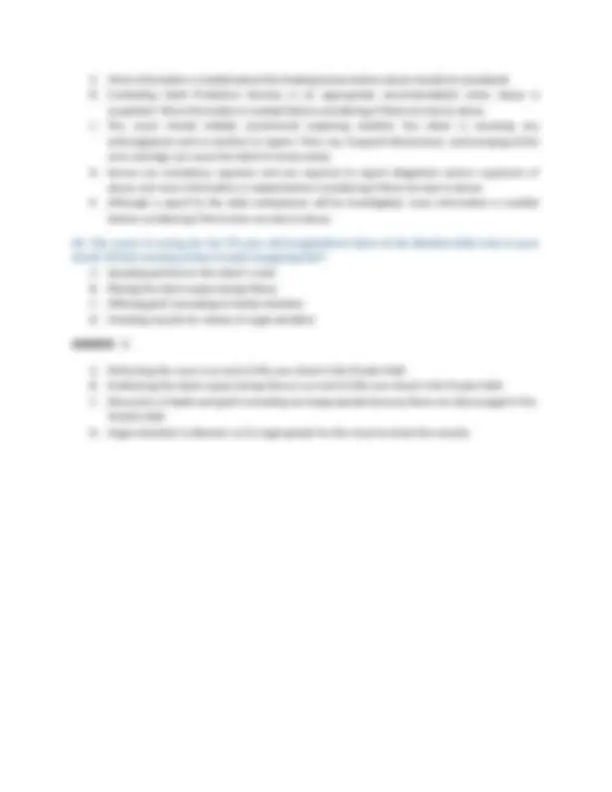


Study with the several resources on Docsity

Earn points by helping other students or get them with a premium plan


Prepare for your exams
Study with the several resources on Docsity

Earn points to download
Earn points by helping other students or get them with a premium plan
Community
Ask the community for help and clear up your study doubts
Discover the best universities in your country according to Docsity users
Free resources
Download our free guides on studying techniques, anxiety management strategies, and thesis advice from Docsity tutors
CARE OF ADULTS EXAM QUESTIONS AND CORRECT ANSWERS ALREADY GRADED A+
Typology: Exams
1 / 29

This page cannot be seen from the preview
Don't miss anything!






















1. The unsteady 20S-year-old client persists in ambulating to the bathroom alone despite being reminded to call for assistance. The nurse concludes that, according to Havighurst’s developmental tasks, this behavior reflects which need of the client? A. Adjusting to physiological changes B. Independence C. Industry D. Integrity ANSWER: B A. Adjusting to physiological changes is a develop- mental task of middle age. B. The client is attempting to perform self-care and to demonstrate the ability to be self- sufficient and independent from other adults. C. Industry is one of Erikson’s developmental tasks, not Havighurst’s. Industry versus inferiority occurs from ages 6 to 12 years. D. Integrity is one of Erikson’s developmental tasks, not Havighurst’s. Integrity versus despair occurs at 65 years and older. 2. The nurse is completing an assessment on the 19 year - old female who participates in strenuous physical activities many hours daily. Which nursing assessment is most important? A. Check for the presence of lordosis. B. Look for signs of an eating disorder. C. Examine muscles for increased mass. D. Ask about excessive bleeding with menses. ANSWER: B A. Strenuous physical activity does not cause lordosis (excessive inward curvature of the spine in the lower back). Lordosis is common in children before age 5. B. Females who participate in strenuous physical activities are at risk for eating disorders. C. An increase in muscle mass is expected with physical activity; thus, it would not be the most important assessment. D. Delayed menses, not excessive bleeding, would be a concern with strenuous physical activity. 3. The nurse is assessing the chest of the normally healthy adult male client without chest abnormalities. Which chest curvature illustrated should the nurse expect to observe?
A. Illustration A B. Illustration B C. Illustration C D. Illustration D ANSWER: C A. Illustration A is pectus excavatum, or funnel chest, caused by stemal retraction. B. Illustration B is pectus carinatum, or pigeon breast, with sternal bulging. C. The normal adult chest has an anteroposterior - to-lateral ratio of approximately 1:2 and a costal angle less than 90 degrees. There should be no sternal or intercostal retractions or bulging at rest. D. Illustration D is barrel chest with increased anteroposterior diameter of the chest, with near- parallel rib sloping and a costal angle greater than 90 degrees. Barrel chest occurs with COPD.
4. The nurse teaches the 18-year-old diabetic client to perform self-administration of insulin. Each time the client makes even a small mistake, the client apologizes for getting it wrong- The client also profusely apologizes when making a minimal mistake in other activities. Based on Erikson’s developmental stages, the nurse concludes that the client may have an unresolved developmental task of which age period? A. Infancy B. Early childhood C. School- aged childhood D. Adolescence ANSWER: B
D. The nurse should ask about alcohol use. Regular consumption of three or more alcoholic drinks a day increases the risk of hypertension and decreases immune competence. E. The nurse should ask about sexual activity. Multiple sex partners and anal sex are risk factors for STIs and HIV.
7. The nurse assesses that a hospitalized 20-year-old college student is anxious and not able to concentrate when given self-care instructions. Which intervention should the nurse implement to assist the client to deal with the stress of hospitalization? A. Have one parent stay in the room when the client is anxious B. Encourage using a cell phone or Internet to talk with friends C. Contact psychiatry to discuss treatments for depression D. Reinforce multiple times how best to perform self-care ANSWER: B A. A young adult is not in need of constant accompaniment of a parent and may find this intrusive. B. To enhance coping, the nurse should focus on the developmental needs of a young adult, which include interaction with peers. Finding ways to help the client communicate with friends, such as using a cell phone or the Internet, may assist in dealing with the stress of the hospitalization and trauma. C. The client’s behavior does not indicate depression. D. Reinforcing information focuses on the injuries and self-care and not on the emotional needs of the client for stress management. 8. The nurse is obtaining nutrition information from four 20-year-old female clients. All have a BM] of 20 to 23. Which client requires the most immediate follow-up? A. The client eats three nutritious meals a day with no snacks. B. The client limits her intake to 2500 calories per day. C. The client eats only fruits, vegetables, seeds, and nuts. D. The client eats three 350-calorie meals per day. ANSWER: D A. The meals are nutritious and may contain enough calories whereby snacks are not required. B. This is an appropriate caloric intake for an average young adult female. C. The client is eating a vegetarian diet. The nurse should further assess for protein sources, but the diet would not cause immediate concern because beans and nuts contain protein. D. By limiting meals to only 350 calories at a time, the client is only consuming 1050 calories per day. This does not meet the basic energy needs for a sedentary female. Further follow-up is required immediately.
9. The 32-year-old has been trying to get pregnant for the past 10 years- The client consults a family planning clinic after being unsuccessful with the calendar and basal body temperature methods in determining the time of ovulation. Which statement by the nurse would be most appropriate? A. “Let me review the methods with you; maybe you have not been using them correctly.” B. “Have you considered that you might not be ovulating and that adoption is an option?” C. “Test kits are available that will detect an enzyme in cervical mucus that signals ovulation.” D. “If your spouse wears restrictive underwear, this can reduce your chance of conception.” ANSWER: C A. Offering to review the methods is not the most appropriate response because the client has been unsuccessful for 10 years. B. Suggesting adoption is premature because other options to test ovulation are still untried. C. It is most appropriate for the nurse to suggest an ovulation test kit. These are available over the counter and are easy to use and considered reliable. The kit can detect the presence of guaiacol peroxidase, the enzyme in cervical mucus that signals ovulation 6 days beforehand. D. Providing information about a male’s restrictive underwear reducing the chance of conception does not address the problem of determining the time of ovulation. 10. The nurse is caring for the 55-year-old client. Which statement by the client related to psychosocial changes should the nurse most definitely explore? A. “I really don’t want to color my hair, even though it seems to be getting grayer every day.” B. “I can’t see as sharp anymore. I get frustrated by the small lettering on the medicine bottles.” C. “My husband and I have a more active sexual life now that the children are out of the house.” D. “My house is empty; I thought I’d be happy when my children finally left, but I feel lonely.” ANSWER: D A. A normal physiological change in the middle years is graying hair. This is an appropriate response that does not require follow-up. B. A change in eyesight occurs in the middle years and should he further explored, but this is a physiological and not psychosocial change. C. Although sexual changes occur in middle age, this statement indicates that the client has a healthy sexual relationship. D. The client’s statement suggests that the client may be experiencing empty nest syndrome. This is a psychosocial concern that the nurse should further explore with the client. 11. The nurse is assessing a healthy middle-aged adult. Which finding should the nurse expect? A. Weight gain of 20 pounds in the past year B. Tactile fremitus is absent at the apex of the lungs C. Counts backward from 100 subtracting 7 each time D. Percussion shows heart is larger than at last checkup
A. Making the workplace a better place to work suggests that the client has an interest in future generations and is in the stage of generativity. B. Volunteering shows interest in others and in making a contribution to the community; it is in the stage of generativity. C. Having a self—focus and displaying a disinterest in the activities of others suggest self- absorption and an inability to play a role in the development of the next generation; this can result in stagnation. D. Pictures showing the client involved with the grandchildren demonstrate the client’s interest in future generations and the stage of generativity.
14. The nurse is assessing the 50-year-old female client who is hospitalized. The nurse should assess the client for which physical changes associated with aging? Select all that apply. A. Increased sweat gland activity B. Decreased ability to read smaller print C. Weight loss due to hypennetabolism D. Increased sebaceous gland activity E. Absence of a menstrual cycle ANSWER: B. E A. Sweat gland activity decreases, not increases, with aging. B. Visual acuity declines in middle-aged adults, often by the late 405, especially near vision. C. Weight gain, and not weight loss, occurs due to a slowing of metabolism occurring with aging. D. Sebaeeous gland activity decreases, not increases, with aging. E. Hormonal changes result in menopause, most commonly between ages 40 and 55 years. 15. The home health nurse is caring for the middle-aged client who is disabled due to a recent accident. The client has few interests, spends most days watching TV, and has become estranged from the family. Which of Erikson’s developmental stages should the nurse conclude that the client is not meeting? A. Industry versus inferiority B. Initiative versus guilt C. Generativity versus stagnation D. Intimacy versus isolation ANSWER: C A. “Industry versus inferiority” is the developmental stage for the school-aged child, 6 to 12 years. B. “Initiative versus guilt” is the developmental stage for the preschool aged child, 3 to 5 years. C. The central task of adulthood is “generativity versus stagnation.” The client has indicators of negative resolution of this developmental stage. D. “Intimacy versus isolation” is the developmental task for young adulthood, 18 to 25 years.
16. The nurse is caring for the hospitalized 60-year-old client of Korean American ethnicity. Which statement, if made by the client. Correctly reflects the Korean American culture and should alert the nurse that intervention is needed? A. “Since 60 is considered old age, I retired as expected. I‘m now worried about insurance.“ B. “Value is on youth and beauty; so little attention is paid to problems of the elderly.” C. “Fathers are expected to continue to contribute financially even for their adult children.” D. “Grandchildren are raised by the grandparents until school age, so we have a full house.” ANSWER: A A. In the Korean American culture, 60 is considered old age, and elders are expected to retire. At a retirement age of 60, the client does not yet qualify for Medicare insurance coverage. A social worker consult may be needed to discuss insurance options. B. The European American and not the Korean American culture focuses on youth and beauty. C. Giving money to adult children is not an expectation of any one culture specifically. D. African American, and not the Korean American, grandmothers often raise grandchildren and offer economic support-
17. The 50-year-old asks the nurse how to calculate BM]. The client weighs 134 1b and is 5’3” tall. Together, the client and nurse calculate the client’s BMI rounded to the nearest tenth. What is the client’s BMI? _ ________ **(Record your answer rounded to the nearest tenth.) ANSWER: 23.
A. Writing thank-you notes to friends indicates that the client is trying to maintain social relation- ships, which is one of the developmental tasks of middle adulthood. B. Stays at home and refuses visitors may interfere with maintaining social relationships, which is one of the developmental tasks of middle adulthood. C. Self-absorption may interfere with maintaining social relationship, which is one of the developmental tasks of middle adulthood. D. Attempting to perform self-care activities shows initiative and interest in improving one’s health and will not interfere with the developmental tasks associated with middle adulthood. E. Continually relaying feelings of inadequacy may interfere with the client’s ability to improve his or her health status and to resume a career. This may interfere with achieving the developmental tasks of middle adulthood.
21. The nurse is caring for the 50-year-old client who reports having difficulty falling asleep. Which recommendations should the nurse make to this client? Select all that apply. A. Drink a glass of wine or a beer before bedtime. B. Avoid exercising 2 to 3 hours before bedtime. C. Go to bed at the same time each night. D. Watch television in bed just before bedtime. E. Avoid eating large or spicy meals in the evening. ANSWER: B , C, E A. Alcohol should be avoided before bedtime. Although alcohol may initially cause drowsiness, it can cause wakefulness alter a few hours of sleep. B. Exercising before bedtime is stimulating and can cause wakefulness. Avoidance of exercise near bedtime promotes a good sleeping habit. C. Going to bed at the same time each night programs the body to expect to sleep at a certain time and influences circadian rhythms. D. Watching television or using technology in bed is stimulating and makes it difficult to disengage and fall asleep. The light from these can also alter circadian rhythms. E. Food remains in the stomach for 2 to 4 hours after eating. Lying down with a full stomach or eating spicy foods can cause indigestion, keeping a person awake. Spicy foods are also thought to increase body temperature, disturbing the nervous system and hormonal mechanisms that initiate sleep. 22. The nurse is interviewing an 80-year-old client who has urinary incontinence. The client is taking furosemide. When asked about daily fluid intake, the client states, “I drink 2 glasses of water, 1 glass of milk, and a half glass of juice. I don’t drink coffee or tea.” Which responses by the nurse are appropriate? Select all that apply. A. “Your fluid intake should be 6 to 8 glasses of water, plus other fluids-” B. “Your fluid intake is adequate and may help to reduce your incontinence.” C. “Caffeine increases urination; it is good that you avoid drinking coffee.”
D. “Your fluid intake is limited; this increases your risk for dehydration.” E. “Your fluid intake is sufficient to maintain a fluid and electrolyte balance.” ANSWER: A , C, D A. To promote a fluid and electrolyte balance and to prevent dehydration, older adults should consume 6 to 8 glasses of water, plus other fluids. B. The client’s fluid intake is inadequate, not adequate. Incontinence may increase when fluids are inadequate because concentrated urine irritates the bladder and urinary sphincter. C. Caffeine has a diuretic effect and can cause dehydration if consumed in excess. D. The total daily fluid intake is 3% glasses of liquids. This is insufficient and can lead to dehydration and electrolyte imbalances, especially when taking the diuretic furosemide (Lasix). E. The client’s fluid intake is inadequate (not sufficient) and can increase the client’s risk for dehydration and electrolyte imbalances, especially since the client is on a diuretic, which promotes fluid excretion.
23. The nurse educator is planning teaching for other nurses after noting that some nurses need additional education on insulin types and how to use the new insulin injection pens. When planning teaching, which question by the educator best reflects consideration that the nurses are adult learners? A. “Does anyone want to volunteer to prepare a poster board and help with handouts?” B. “What do you need to learn about insulin, and what teaching method would you prefer?” C. “Can you attend a presentation if I post various times during the day and evening shift?” D. “What don’t you understand about the information in the policy and procedure manual?” ANSWER: B A. Adults learn best by demonstration and hands-on practice. A poster board does not support adult learning styles. B. Adults are independent learners. Before deciding what nurses do not know, the nurses them- selves should identify their specific learning needs and the methodology for learning. C. Adults learn best by demonstration and hands-on practice. A presentation does not support adult learning styles. D. Asking staff what they don’t understand about the policy and procedure is threatening. 24. The nurse has limited time to teach the middle-aged adult client- The nurse should initially plan to take which action? A. Provide brochures and handouts that the client can discuss with family members. B. Make a referral to outpatient resources for the client to receive the needed teaching- C. Establish the highest-priority learning needs and teach with each client or family contact. D. Answer the client’s questions and leave the extensive teaching for the nurse on the next shift. ANSWER: C
26. The nurse is reviewing a laboratory report for a 61—year-old client. Which finding is most important for the nurse to address with the HCP? A. Total cholesterol 180 mg/dL ; was 140 at age 50 B. Erythrocyte sedimentation rate (ESR) increased C. Alkaline phosphatase increased D. AST, ALT, and serum bilirubin increased ANSWER: D A. Total cholesterol increases by 30 to 40 mg/dL with aging. This value is still less than 200 mg/dL. B. ESR increases with aging for unknown reasons. C. Alkaline phosphatase is an enzyme found throughout the body that increases with aging. D. It is most important for the nurse to notify the HCP if liver function tests are elevated. AST, ALT, and serum bilirubin are liver function tests that are unchanged with age.
27. While attending a health fair, the 62-year-old female is found to have many risk factors for osteoporosis. The nurse at the booth recommends that she contact her HCP about scheduling a DEXA (dual-energy x-ray absorptiometry) scan. Which risk factors influenced the nurse’s recommendation? Select all that apply. A. Hyperthyroidism B. Postmenopausal C. Overweight D. African American E. 62-year-old female ANSWER: A , B, E A. Too much thyroid hormone can cause bone loss. B. Estrogen levels decrease at menopause, and this decrease is one of the strongest risk factors for osteoporosis. C. A thin body structure rather than being overweight is a risk factor for osteoporosis. Being overweight can contribute to the development of OA. D. Major risk factors for osteoporosis include white or Asian race, not African American- E. Advancing age and being female are both risk factors for osteoporosis. 28. The 62-year-old client is diagnosed with osteoporosis. Which medication, if taken by the client, should the nurse identify as posing a secondary risk factor for the client’s osteoporosis? A. Baby aspirin daily for past 4 years B. Escitalopram 5 mg daily for past 7 months C. Multivitamin for many years D. 10-year use of budesonide nostril spray bid ANSWER: D
A. Baby aspirin, used for its cardioprotective effect, has not been identified to cause bone loss (osteoporosis). B. Escitalopram (Lexapro), an antidepressant, has not been identified to cause bone loss (osteoporosis). C. The calcium and vitamin D supplement in multivitamins is helpful in preventing bone loss. D. Long—term use of corticosteroids, such as budesonide (Pulmicort), should be identified as a risk factor for osteoporosis.
29. The 66-year—old client recently retired after working 30 years as a bank manager. Which statement to the nurse during a clinic visit best suggests that the client is achieving the developmental stage of “integrity versus despair”? A. “Now that] have some free time, I want to treat my wife to a trip to Hawaii.” B. “I seem to be staying in bed longer and longer each day. There isn’t a reason to get up now.” C. “I am noticing the little aches and pains more; before I was just too busy to notice them-” D. “I get calls a few times a week for advice; my coworkers still value my suggestions.” ANSWER: D A. Option 1 is a statement reflecting positive resolution of generativity versus stagnation, showing concern for others- B. Option 2 indicates that the client is experiencing difficulty achieving the developmental stage. C. Option 3 is not reflective of any stage. D. “Integrity versus despair” is Erikson’s stage of development from 65 years of age and older. Indicators of positive resolution include statements of acceptance of worth and uniqueness of one’s own life. 30. The nurse is assessing the 84-year-old client during a routine health examination. Which finding should the nurse investigate first? A. Decreased force of cough B. Impaired swallowing C. Urine light yellow in color D. Height decreased by ½ inch ANSWER: B A. Decreased force of cough is an age-related change. Although important to investigate further to rule out an underlying respiratory condition, this is not priority. B. Gastric motility decreases with aging, but impaired swallowing can be due to other conditions and increases the client’s risk for aspiration. This should be investigated first. C. Decreased urine concentration is an age-related change. Although important to investigate further to rule out an underlying renal condition, this is not priority. D. Height decreases with aging. Although important to investigate further to rule out an underlying medical condition, this is not priority.
A. Shame would be from a sense of guilt; there is no evidence of guilt in the client’s comment. B. The client’s comments do not reflect anxiety. C. Havighurst’s developmental tasks of later maturity include positive behaviors and adjustments, such as adjusting to decreasing physical strength and health. The client’s comments indicate lack of adjustment. D. Indicators of a negative resolution (despair) include contempt for self or others and a sense of loss. Indicators of positive resolution (integrity) include acceptance of worth and acceptance of death.
34. The nurse assesses the 75-year-old client and concludes that some findings are not age— related changes and require further follow-up. Which report by the client represents a non- age-related finding that requires additional investigation? A. Reports a decreased ability to see at night B. Reports seeing halos around lights C. Reports difficulty distinguishing some colors D. Reports diminished visual acuity ANSWER: B A. The lens increases in density and rigidity, which cause the older adult client’s night vision to decrease. B. Seeing halos is not a normal age-related vision change. Halos are classic symptoms of glaucoma. C. The lens increases in density and rigidity, which reduce the client’s ability to distinguish some colors. D. Age-related changes include a decrease in the size of the pupil, limiting the amount of light entering the eye. 35. The experienced nurse is observing the new nurse recommend screening tests to the 80- year-old female client- Which recommendation made by the new nurse should the experienced nurse correct? A. Hearing screen annually B. Colonoscopy every 10 years C. Pneurnocoecal vaccine annually D. Mammogram every I to 2 years ANSWER: C A. Hearing screen should be performed annually for older adults because hearing loss occurs with aging. B. Colonoseopy should be performed every 10 years unless the client is at high risk; there is no indication of this in the question stem. C. Pneumocoeeal vaccine is administered at age 65 and every 10 years, not annually. An influenza vaccine should be administered annually. D. Mammogram should be performed every 1 to 2 years to rule out the presence of a breast mass.
36. The nurse completes teaching for the 80-year-old female client. Which statement made by the client indicates further teaching is needed? A. “Instead of using sodium seasonings, I plan to try one with herbs and lemon.” B. “Although I find my lavender-scented hand cream relaxing, I should not use it.” C. “I should place a towel on the floor outside my shower so I don’t slip when getting out.” D. “Rather than relying on laxatives, I should increase my intake of fruits and vegetables.” ANSWER: C A. Nonsodium seasonings such as herbs, garlic, and lemon are recommended to prevent hypertension. B. Scented lotions increase skin irritation and the risk for skin breakdown; their use should be avoided in older adult clients. C. Placing a towel outside the shower on the floor can increase the client’s risk for a fall. A slip- resistant mat should be used and the towel placed within reach without bending. D. Older adults have decreased GI motility, and laxatives can be overused by those who are constipated; roughage from fruits and vegetables will decrease constipation and the need for laxatives.
37. The 83-year-old tells the nurse, “I’m not taking my medication because it’s too expensive and I really don’t need it anymore.” Before responding to the client, the nurse should consider that the most common reason for older clients to discontinue their medications is which of the following? A. Information about the medications is insufficient. B. Medications alter the taste of foods that they enjoy. C. Fear they will live longer than their resources will last. D. They want the attention from others when they are sick. ANSWER: C A. While older adults may discontinue some medications because they lack sufficient information about them, this is not the most common reason. B. Many medications do alter taste, but this not the most common reason for discontinuing their use. C. Fear of future lack of resources is a common concern of many older adults and results in the failure to comply with medical treatments, including taking prescribed medications. D. Although many older adults may be lonely, few would discontinue their medications to seek attention. Most prefer living as independently as possible. 38. A 72-year-old woman reports she is sexually active. It is most important for the nurse to follow up by asking which question? A. “Can you tell me more about your sexual partners?” B. “Have you tried artificial water-based lubricants?” C. “Are any medications having any drying effects?”
A. Seborrheic keratosis is a benign pigmented lesion with a waxy surface on the face and trunk. B. Acrochordon is a small, benign polyp-growth also known as a skin tag. C. Senile purpura is characterized by areas of ecchymosis and petechiae found on the hands, arms, and legs caused by frail capillaries and decreased collagen support. It is a common skin lesion associated with aging. D. Urticaria is an abnormal lesion that can occur anywhere on the body from an allergic reaction.
41. The nurse overhears a person say, “I’m having a senior moment because I forgot “ How should the nurse interpret this statement? A. This phrase is a comical statement without age bias and is acceptable to others. B. This phrase is a stereotypical reference to older adults that can be termed ageism. C. This phrase admits that the older adult’s ability to learn new information is limited. D. This phrase recognizes that all older adults have short— and long-term memory issues. ANSWER: B A. The statement is biased against older adults. B. This statement is a form of ageism, which comprises the prejudices and stereotypes that are applied to older people and perpetuate negativism against them. C. In older adulthood, the processes of learning new information and recalling old information slow down somewhat, but the overall ability to learn and remember is not significantly affected in healthy older people. D. Although short-term memory may decline with age, not all older adults are affected with short- and long-term memory loss.
42. The nurse is assessing the older adult. Which tool should the nurse select to identify the client’s needs and care deficits? A. Katz Index of Activities of Daily Living B. Maslow’s Hierarchy of Needs C. Mini Mental State Exam (MMSE) D. Erikson’s Developmental Tasks ANSWER: A A. Katz Index of Activities of Daily Living is a widely used functional assessment tool for evaluating the client’s ability to perform daily personal care activities. B. Maslow’s is a human needs theory that is pertinent to everyone. C. The MMSE only assesses cognition. D. Erikson’s theory is a developmental theory differentiating needs of each age group. 43. After performing an assessment and determining that there are no other causes, the nurse concludes that the older adult’s recent hearing loss in one ear may be from cerumen accumulation from age- related changes. The nurse’s conclusion was based on which age- related changes that contribute to the cerumen accumulation? A. Reduced sweat gland activity; thinning and drying of the skin lining the ear canal B. Ossicular bone calcification; longer and thicker hair growth in the ear canal C. Degenerative structural changes of the eardrum preventing cerumen passage D. Over activity of the sweat glands contributing to the development of presbycusis ANSWER: A A. The reduced sweat gland activity causes drying of the wax and a prolapsed or collapsed ear canal. The buildup of wax affects the perception of sounds. Longer and thicker hair growth in the ear canal is also a contributing factor. B. Ossicular bone calcification does not contribute to cerumen buildup, whereas longer and thicker hair growth in the ear canal does. C. Degenerative structural changes of the eardrum do not contribute to excess buildup. D. Presbycusis is age-related sensorineural hearing loss, mostly at higher frequencies and usually occurring bilaterally but may be at different times. This does not relate to the accumulation of cerumen. 44. The nurse is interviewing a family member of the hospitalized 90-year-old client to assess for common problems associated with an increased risk for falling. Which questions should the nurse ask? Select all that apply. A. “Has your mother fallen within the past year?” B. “Has your mother had her annual influenza vaccine?” C. “When was the last time your mother took a pain pill?” D. “Does your mother have any problems with urination?” E. “Does your mother have difficulty falling asleep at night?”